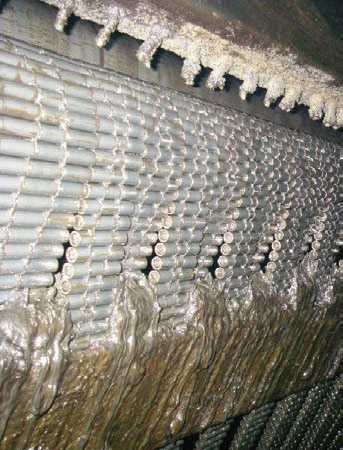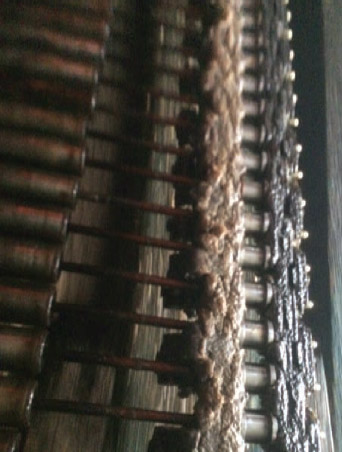Energy saving and wear reduction
8 December 2016An overlooked property of lubricating oils is the residue that they leave under evaporation. A new family of high-temperature oils for the wood panels industry tackles the problem. Anton Kulikov, sales development manager at Klüber Lubrication, explains
Correct and reliable lubrication of the elements of continuous wood based panel presses is important. It enables smooth and trouble-free line operation with optimum production outage. The main lubrication points that require special attention on the press are steel belts, roller rods and bolts/bending rods. Incorrect lubrication of these elements may lead to blocking of bolts/bending rods and damage to the steel belt or even to the heating plates.
Another important production parameter that is influenced by the lubricants is the energy efficiency of the press. While lubricants of course cannot influence the pressure or the temperature required to produce a certain board type, a modification of friction can noticeably decrease the force required to pull the board and the steel belts through the press and therefore reduce the electrical energy consumption on the drum drives.
Oils for high temperatures
The oils which are used on these lubrication points have to withstand high temperatures and high mechanical loads in an aggressive environment. At the same time, the oils used on the wood based panel press should leave only a minimum of residues upon evaporation and should have a certain cleaning effect so that the fresh oil supplied to the friction point is able to remove the residues already formed and the wood dust particles glued to it.
The thermal stability of the oil is traditionally considered to be the most important parameter for panel presses. A low evaporation rate and a high flash point are supposed to provide for minimum oil consumption and to eliminate the risk of fire.
Despite the obvious importance of the thermal behaviour of the oil, experience gained at real-life production sites shows that the main issues with press maintenance comes from residue formation, which causes increased oil consumption, unplanned downtime and increased spare part costs.
High thermal load causes evaporation of the oil, which in turn causes formation of the residue, which consists of non-volatile components and the products of thermal degradation. These residues cause problems, particularly in the roller rod/pin friction point.
The build-up of residue eventually causes pins to block, which leads to automatic press stoppage and the need to replace the pin and drill out the roller rod.
Another consequence of residue formation is relevant for presses with the chain carpet system (see photograph, above right.) Solidified dry residues formed on the chain carpet links block the fresh oil from getting into the friction points. This leads to increased torque due to under-lubrication, while any attempts to fix the problem by increasing the amount of oil supplied to the system will only cause additional fumes in the air.
So it is that high-temperature lubricating oils for continuous wood based panel presses have to possess good thermal stability and load carrying capacity, combined with a minimised tendency to form insoluble residues.
Most of the high-temperature oils for application on wood based panel presses available on the market now are based on the three-component base oil concept. A combination of ester oil, viscosity modifier and a hydrocarbon component, supplemented by an additive package, provide the necessary thermal stability of the oil and regulate its friction properties. However, the three component base oil concept does not solve the complex problem of residue formation and high oil consumption.
New product development & testing
Klüber Lubrication has been an active partner of the wood based panel industry since the first continuous lines were brought to the market around 30 years ago. The expertise which the company has developed over this period has resulted in the development of the fifth generation Klübertherm oil series.
These oils were developed with the idea of combining thermal and mechanical properties with good solubility and minimised formation of residues.
The three-component base oil approach has been reconsidered. The new oils are based on one main base oil component, a viscosity modifier and a renewed additive package. The new high-temperature two-component base oil concept, combined with remodelled additive package, provides significantly improved evaporation rates, residue behaviour and friction properties of the oils. An examination of the evaporation rates of the new belt oil (ISO VG 260) found that at 230°C the new oil evaporates some 20-30% more slowly than the conventional oils recommended for the application.
The same experiment highlights an even more important parameter: the viscosity of the oil that is left after partial evaporation. In practice this characterises the tendency of the oil to become thicker under thermal load.
After being incubated at 230°C for 72 hours, the new oil has a dynamic viscosity of roughly 3,000 mPas (the consistency of honey) while conventional oils show a viscosity of 17,000 to 21,000 mPas (hardly flowable).
The friction behaviour and wear protection have been tested as well. The test was performed on the standard roller chain, which was lubricated (by immersion) once and then run at 220°C under a load of 2600 N. The time needed to achieve 0.1% chain elongation was registered as the result. Under high mechanical and thermal load, when the oil evaporates and the additives are no longer providing adequate protection, excessive wear on the pin-roller friction pair begins to cause chain elongation. Thus, the longer the time elapsed before the 0.1% chain elongation occurs, the better the oil wear protection properties are.
The comparative results of the new belt oil and conventional oils usually used for panel presses were as follows: time to 0.1% chain elongation with the new oil: 22 hours; with other oils, the results were between 12 and 17 hours.
The problem of residue formation was addressed as well. The two base oil components in the new oil series are combined in such a way that after complete evaporation, the residue formed has a soft, powder-like consistency and can be dissolved or suspended by the fresh oil. The tests performed with the new oil series chain oil (ISO VG 100), which is used for lubrication of bending rods and bolts, have demonstrated that the residue remaining after complete evaporation appears soft and can be regenerated by gentle stirring with the fresh oil. In practice, this property of the oil should help prevent pins from blocking and avoid or minimise the time-consuming drilling procedures to mend the roller rods.
The final element in the new oil series is cleaning oil. This is a supplementary product for cleaning and lubrication of the chains, bending rods/bolts and chain carpet systems on continuous wood based panel presses. The cleaning oil is to be used on the press instead of the normal working oil, lubricating bending rods/bolts periodically for a limited period of time. The cleaning additives in the oil dissolve or suspend the pasty residues and flush them away from the lubrication point. In this way it provides a good cleaning effect without disturbing the production schedule.
After the development and testing stage, the new two-component oil series was expected to demonstrate the following advantages over the conventionally used high-temperature oils:
- Decrease energy consumption on the main drives;
- Improve cleanliness of the bending rods/bolts and chain carpets;
- Decrease the volumes of oil needed for smooth press operation.
Oil performance in production
By now, the new oil series has been extensively tested at real-life production sites in all machinery types and with all kinds of boards.
Overall, all the expectations based on the laboratory tests have been met. The effect of the new belt oil on the energy consumption of the drum drives was found to be quite significant in certain cases. The Ampere load drops within two to three hours after the oil change and the value of the energy savings achieved varies significantly depending on the board thickness. Thus, the trial on the 2.15 x 44 m particleboard press demonstrated an Ampere load decrease of 16 to 29%, while the trial on the 8ft x 45.2m MDF board line showed savings of up to 0.68kWh per cubic metre of board produced.
The demonstrated energy savings vary from one line to another and also depend very much on press working conditions. Every press behaves individually and additional influencing factors such as speed, pressure, temperature and many others all act on the lubrication system. It is therefore difficult to predict the precise result that the oil produces on a particular line. The overall trends that were demonstrated in the numerous trials suggest the strongest dependence of energy savings is on the thickness of the board and the speed of the press.
The new chain oil (ISO VG 100) for lubrication of the bending rods/bolts, has been tested on various press lines and demonstrated a very good potential to keep the pin system clean and smooth-running. It thereby significantly decreases the number of pin blockages; or eliminates the problem completely.
Benefits for production
Overall, the experience of using the two component base oil products at production sites has demonstrated potential for the following improvements in the production process:
- Energy saving on the drum drives;
- Minimised wear;
- Minimised maintenance effort required for cleaning the roller rods and replacing the bending rods/bolts;
- Decreased volume of belt oil required to run the press cleanly and smoothly.

